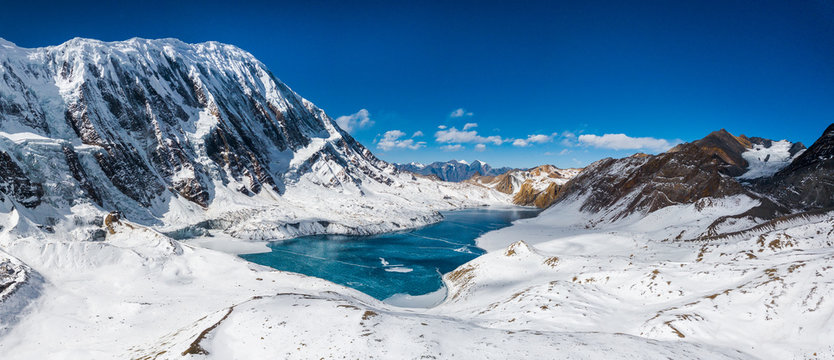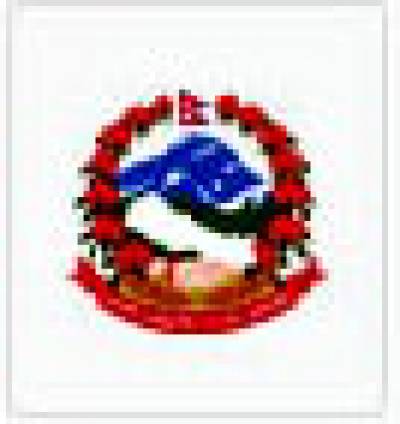ANNAPURNA CIRCUIT TREK VIA TILICHO LAKE 9 DAYS FROM POKHARA
The Annapurna Circuit Trek via Tilicho Lake is an extraordinary journey that combines scenic landscapes, cultural immersion, and an adrenaline-pumping high-altitude trek. The adventure begins in Pokhara, a picturesque city nestled by Phewa Lake, where your trek commences with a local bus ride to Besisahar. From Besisahar, you’ll take a shared jeep to Chame, a small town situated in the heart of the Annapurna region, where the real trekking begins.
From Chame, the trail ascends through beautiful pine forests and traditional villages, leading you to Pisang. Continuing along the route, you’ll pass through the charming Ngawal village, offering incredible views of the surrounding peaks. The trek to Manang takes you further into the heart of the Himalayas, where the landscape starts to become more rugged, and the altitude increases, offering the opportunity to acclimatize while enjoying the breathtaking views.
Next, you’ll head towards Tilicho Base Camp, where you'll prepare for the stunning journey to Tilicho Lake, located at an altitude of 4,919 meters (16,138 feet). This serene lake, nestled between towering peaks, is one of the highest in the world, and the views from here are truly unforgettable. After soaking in the beauty of Tilicho Lake, you’ll return to Shree Kharka, Yak Kharka, and then Thorong Phedi to prepare for the crossing of the famous Thorong La Pass.
At 5,416 meters (17,769 feet), Thorong La is one of the highest trekking passes in the world. Crossing the pass is an exhilarating experience, offering sweeping views of the Annapurna and Dhaulagiri ranges. After descending from the pass, you’ll reach the sacred town of Muktinath, known for its religious significance and stunning views.
Finally, after completing this incredible journey, you’ll trek back down to Pokhara by local bus, bringing this unforgettable adventure to a close.
ITINERARY
Day 1 : Drive from Pokhara to Chame (2,710m/8,890ft) – Duration: 8-10 hours.
Your adventure begins with a scenic drive from Pokhara to Chame, the administrative center of the Manang district. The drive takes 8 to 10 hours, traveling on a rugged, winding road through picturesque villages, dense forests, and terraced fields. Along the way, you'll be treated to panoramic views of the Himalayas. Upon arrival in Chame, you'll have a chance to rest and prepare for the trek ahead, with the option to explore this small but charming town nestled in the heart of the Annapurna region.
Day 2 : Trek to Pisang (3,115m/10,200ft) – Duration: 4-5 hours.
After breakfast, you’ll begin your trek towards Pisang. The day’s trek lasts around 4 to 5 hours, taking you through pine forests and traditional villages. The trail gently ascends as you walk along the Marsyangdi River, passing through small settlements and witnessing the ever-increasing views of Annapurna II and other peaks. Once you reach Pisang, a picturesque village, you’ll enjoy the stunning surroundings and the distinct architecture typical of this region. Spend the night in one of the local teahouses.
Day 3 : Trek to Manang (3,540m/11,300ft) via Ngawal Village – Duration: 6-7 hours.
Today, you’ll trek towards Manang, passing through the village of Ngawal, which is renowned for its beautiful traditional houses and spectacular mountain views. The trek is about 6-7 hours, and as you gain altitude, you’ll begin to notice the changes in vegetation and climate. The trail winds through alpine forests and offers expansive views of the surrounding mountains. Upon reaching Manang, a vibrant Sherpa village, you’ll have time to rest and acclimatize to the altitude. Manang is a popular stop for trekkers, offering a chance to explore the local culture and stunning landscapes.
Day 4 : Trek from Manang to Tilicho Base Camp (4,150m) – Duration: 5-6 hours.
The trek to Tilicho Base Camp from Manang takes about 5-6 hours. The trail ascends gradually, passing through higher-altitude landscapes with rugged terrain. As you approach the base camp, you’ll be surrounded by dramatic mountain views, including the majestic Tilicho Peak. The altitude begins to feel more pronounced, so it’s important to pace yourself. The journey offers a unique perspective on the Annapurna range. At Tilicho Base Camp, you'll rest for the night, preparing for the next day’s exciting visit to Tilicho Lake.
Day 5 : Hike to Tilicho Lake (4,920m) & Return to Base Camp, then Trek to Shree Kharka – Duration: 7-8 hours.
Today is one of the highlights of the trek—visiting Tilicho Lake, located at an altitude of 4,920 meters (16,138 feet). The hike from Tilicho Base Camp to the lake is challenging but offers magnificent views of the surrounding snow-capped peaks. After spending time at the lake, you’ll return to the base camp and then continue the trek to Shree Kharka. The trek today takes approximately 7-8 hours, including the time spent at Tilicho Lake. Shree Kharka is a small village where you can rest and acclimatize before continuing your journey.
Day 6 : Trek from Shree Kharka to Yak Kharka (4,200m) – Duration: 5-6 hours.
From Shree Kharka, the trail ascends steadily as you make your way towards Yak Kharka. The trek takes around 5-6 hours, passing through open meadows and alpine terrain. The path becomes more barren as you gain elevation, but the views are nothing short of spectacular. As you approach Yak Kharka, you’ll start to notice the increased presence of yak herders and their animals. This quiet, remote village offers a peaceful place to rest and acclimatize.
Day 7 : Trek from Yak Kharka to Thorong Phedi (4,500m) – Duration: 3-4 hours.
Today’s trek is relatively short but essential for your acclimatization. You’ll trek for 3-4 hours from Yak Kharka to Thorong Phedi, a village located at the base of Thorong La Pass. The trail today passes through more barren landscapes, with expansive views of the surrounding valleys. Thorong Phedi is the final stop before crossing the high-altitude Thorong La Pass. Take time to rest and hydrate, as the next day’s trek will be challenging.
Day 8 : Trek from Thorong Phedi via Thorong La Pass (5,416m) to Muktinath (3,802m) – Duration: 7-9 hours.
This is the most challenging day of the trek, as you will cross the famous Thorong La Pass. Starting early in the morning, you’ll begin your ascent towards the pass, which sits at 5,416 meters (17,769 feet). The climb can be strenuous, but the views from the pass are incredibly rewarding. Once at the top, you'll have breathtaking panoramic views of the Annapurna and Dhaulagiri ranges. After taking in the scenery, you’ll descend to Muktinath, a sacred pilgrimage site for both Hindus and Buddhists. The descent takes around 3-4 hours, and upon reaching Muktinath, you can explore the temples and holy sites.
Day 9 : Drive to Pokhara (850m/2,788ft) – Duration: 8-9 hours.
On the final day of your trek, you’ll take a long, scenic drive from Muktinath to Pokhara. The drive takes approximately 8-9 hours, passing through the Kali Gandaki River valley, villages, and agricultural land. The journey back to Pokhara offers a chance to reflect on your incredible adventure in the Annapurna region. Upon arrival in Pokhara, you’ll be transferred to your hotel for a well-earned rest.
SERVICES
Cost Included in Your Package
- Drive from Pokhara to Besisahar by local bus and Besisahar to Chame by local shared Jeep.
- Drive from Muktinath to Pokhara by local bus at the end of the trek.
- Tea House/Lodge accommodation during the trek.
- Three meals a day (Breakfast, Lunch, and Dinner) are provided throughout the trek.
- Experienced and qualified trek leader (guide) with a government license, and an assistant trekking guide for groups of 8 or more trekkers.
- Porter service: One porter for every two trekkers to help carry your luggage.
- Porters' coverage: Their salary, food, accommodation, insurance, and safety equipment.
- The Annapurna Conservation Area Permit (ACAP) fee is included.
- The Trekkers Information Management System (TIMS) card fee is covered.
- Use of trekking gear: Sleeping bag, down jacket, duffel bag, and walking poles (if you don't have your own), to be returned after the trek.
- Assistance with emergency rescue operations (funded by your travel insurance) in case of severe health conditions.
- Sherpa Expedition and Trekking appreciation certificate after completing the trek.
- Oxygen meter to check your pulse, oxygen saturation, and heart rate twice daily, ensuring your health and safety during the trek.
Cost Not Included in Your Package
- International Flight to and from Nepal.
- Nepal entry visa fee: Visas can be obtained easily on arrival at Tribhuvan International Airport, Kathmandu. The fees are as follows:
- $30 USD for a 15-day visa
- $50 USD for a 30-day visa
- $125 USD for a 90-day visa
- Accommodation and meals in Pokhara (other than those provided during the trek).
- Extra night accommodation in Kathmandu or Pokhara due to early arrival, late departure, or early return from trekking for any reason outside the scheduled itinerary.
- Personal expenses such as shopping, snacks, bar bills, tea, coffee, hot water, bottled or boiled water, shower fees, Wi-Fi, laundry, telephone calls, battery recharges, extra porters, etc.
- Personal clothing and gear not provided in the package.
- Travel insurance: It is strongly recommended to have insurance that covers trekking in high-altitude areas.
- Tips for your guide and porters, which is customary in Nepali culture.
- Additional costs or delays caused by circumstances beyond our control, such as landscape changes, bad weather, itinerary modifications for safety, illness, changes in government policy, political instability, strikes, or other unforeseen events.
- NOTE: If you return earlier from the trek due to sickness or any other reason, expenses for flights, hotels, meals, and other services are nonrefundable. You will be responsible for any additional costs incurred in Kathmandu or Pokhara.
EQUIPMENTS
The following information will give you some idea about what you need to bring for the trek. It is important you do not forget the essential items, as this will determine your comfort and safety on the trek. Equally important is that you do not burden yourself with unnecessary equipment on the trek.
- Sleeping Bag (Sherpa Teams will provide but need to return after completing the trip)
- Duffel Bag (Sherpa Teams will provide but need to return after completing the trip)
- Fleece jacket or pullover
- Waterproof windbreaker or windcheater
- Thermal underclothes
- Rain poncho
- Down jacket (Sherpa Teams will provide but need to return after completing the trip)
- Fleece or wool trousers
- Sun hat or scarf
- Trekking pants (two pairs)
- Mittens or woolen gloves
- Hiking socks (several pairs)
- Moisture-wicking shirts, including t-shirts
- Trekking shoes or boots with spare laces
- Flip-flops or sandals for relaxing in the evenings
- Underwear (several pairs)
- Swimsuit or swimming costume
- Sunglasses
- Headlamp or flashlight/torch
- Sleeping bag (Sherpa Teams can provide this for you)
- Trekking poles (if desired)
- Hiking backpack with a capacity of at least 40 liters
- Small lock for your backpack
- Reusable water bottles (at least two liters)
- Water purification tablets or filtration device
- Wash towel
- Basic first aid kit
Toiletries (tissues, toilet paper, moisturizer, lip balm, sunscreen, sanitary pads, hand sanitizer, nail clippers, a small mirror, toothbrush, toothpaste, glasses, contacts, etc.)
GOOD TO KNOW
📅 Best Time to Trek
The best times to trek the Annapurna Circuit via Tilicho Lake are during the spring (March to May) and autumn (September to November). These seasons offer clear skies, moderate temperatures, and stunning views of the Himalayas, making them ideal for trekking. Winter can be too cold, especially at high altitudes, while summer monsoon season may bring heavy rains, making the trails slippery and less accessible.
🚶♂️ Trek Difficulty
The Annapurna Circuit Trek is considered a moderately challenging trek. The trek involves high-altitude climbs, including crossing Thorong La Pass at 5,416 meters (17,769 feet), and long daily hikes. Some prior trekking experience, especially in high-altitude environments, is recommended. However, with proper acclimatization and preparation, trekkers of average fitness levels can complete the trek.
🏡 Accommodation
Accommodation along the Annapurna Circuit Trek is in tea houses or lodges, offering basic but comfortable amenities. These teahouses provide a warm place to rest, meals, and an opportunity to interact with fellow trekkers and locals. As you ascend higher, the facilities become more basic, but the hospitality remains warm, especially in smaller villages like Ngawal, Manang, and Yak Kharka.
🌍 Altitude Considerations
The highest point of the trek is Thorong La Pass (5,416 meters), which requires proper acclimatization. Altitude sickness can occur above 3,000 meters, so it's important to take rest days, stay hydrated, and avoid rushing. Symptoms of altitude sickness include headaches, dizziness, and nausea. It's essential to listen to your body and descend if necessary to ensure your safety.
🎒 Packing Tips
Packing light but smart is key for the Annapurna Circuit Trek. Essential items include a good pair of hiking boots, warm clothing (layers), waterproof gear, a sleeping bag for cold nights, sunscreen, a hat, and a first-aid kit. Don’t forget a water purification method and trekking poles to assist with the more challenging parts of the trek.
🙏 Local Culture
The Annapurna Circuit passes through diverse villages, allowing trekkers to experience the rich culture of the Gurung, Manangi, and Thakali people. Be respectful of local customs, dress modestly, and take time to learn about the region’s Buddhist and Hindu traditions. Visiting monasteries along the way provides deeper insight into the spiritual life of the region.
🛣️ Trail Accessibility
The trail is well-established and marked, but some parts, particularly after the crossing of Thorong La Pass, can be strenuous. Local transport, such as buses or jeeps, are available in some areas like Pokhara to Besisahar and Chame, helping to reduce the time spent on the road. The trek is mostly done on foot, and it’s recommended to take the journey at a comfortable pace to fully enjoy the views and experiences.
💧 Water and Hydration
Staying hydrated is crucial during the trek. While water sources are available along the route, it's a good idea to carry a water purification system (e.g., tablets or a filter). Bottled water is sold in most villages, but it is more expensive than refilling from natural sources. Drink plenty of water to stay acclimatized and avoid dehydration.
🚑 Emergency and Safety
While the Annapurna Circuit is a popular trekking route, it’s important to be prepared for emergency situations, particularly in higher altitudes. Ensure you have a local guide or porter with you for navigation and safety. In case of emergency, there are health posts in some villages, and helicopter rescue services are available if necessary. Travel insurance covering high-altitude trekking is essential.
🛒 Permits and Documentation
To trek the Annapurna Circuit, you'll need to obtain the Annapurna Conservation Area Permit (ACAP) and the TIMS (Trekkers' Information Management System) card. These permits can be arranged in Pokhara or Kathmandu. Ensure you have valid identification (passport) and permits before starting your trek.
MAP
PHOTOS/Videos
Departures
Select a departure month
Fill out the form below and a Travel Expert will reach out to create your perfect tour.
FAQS
What is the Annapurna Circuit Trek via Tilicho Lake?
The Annapurna Circuit Trek via Tilicho Lake is a high-altitude trekking route in the Annapurna region of Nepal. The trek takes you around the Annapurna massif, with an additional detour to Tilicho Lake, one of the highest lakes in the world, before crossing the famous Thorong La Pass and descending to Muktinath.
How long is the Annapurna Circuit Trek via Tilicho Lake?
The trek typically takes around 9 days, starting from Pokhara. The duration includes acclimatization days and the opportunity to explore the stunning landscapes, villages, and the famous Tilicho Lake and Thorong La Pass.
How difficult is the Annapurna Circuit Trek via Tilicho Lake?
The trek is considered moderately challenging. It involves long daily hikes and high-altitude crossings, particularly Thorong La Pass at 5,416 meters (17,769 feet). Previous trekking experience, good fitness, and acclimatization are important for completing this trek.
When is the best time to do the Annapurna Circuit Trek via Tilicho Lake?
The best times to trek are during spring (March to May) and autumn (September to November). These seasons offer clear skies, mild temperatures, and stunning views of the Himalayas, making it ideal for trekking.
What permits are required for the Annapurna Circuit Trek via Tilicho Lake?
You will need the Annapurna Conservation Area Permit (ACAP) and a TIMS (Trekkers' Information Management System) card. These permits can be arranged in Pokhara or Kathmandu before starting your trek.
Do I need a guide or porter for the trek?
While it's possible to trek independently, hiring a guide is highly recommended for safety, navigation, and cultural enrichment. A guide can also help with the language barrier and provide information about local traditions. A porter can be hired to carry your heavy gear, allowing you to focus on the trek.
What type of accommodation can I expect on the trek?
Accommodation along the Annapurna Circuit consists of basic tea houses and lodges. These provide simple rooms and meals, with warm hospitality. As you ascend to higher altitudes, the facilities become more basic, but the views and cultural experiences are worth it.
How high is Tilicho Lake, and is it safe to visit?
Tilicho Lake is located at an altitude of 4,919 meters (16,138 feet). While it’s safe to visit, proper acclimatization is essential due to the high altitude. Be aware of altitude sickness symptoms and take necessary precautions, such as resting and staying hydrated.
How do I get from Pokhara to the starting point of the trek?
From Pokhara, you’ll take a local bus to Besisahar, followed by a shared jeep to Chame, where your trek begins. The journey takes about 6-7 hours to reach Chame and offers beautiful views of the surrounding hills and valleys.
How long is the trek each day?
On average, the daily trekking duration is about 5-7 hours, with some days being longer, especially when crossing Thorong La Pass. The trek is designed to allow proper acclimatization, so the distance covered each day varies based on altitude and terrain.
Latest Traveller’s Reviews
Travel experiences of our clients who recently returned from their trips.
100%
Based On 5470 Reviews
Emily Zhao
Singapore
May 28, 2025
Professional Trek, Heartfelt Memories – Led by Tshering
I signed up for the Annapurna Base Camp trek with Sherpa Expedition based on a friend’s recommendation, and now I can confidently say it was the best travel decision I’ve ever made. Our guide, Tshering, was truly special. Calm, experienced, and incredibly warm-hearted, he guided us through every step with confidence and care. What I admired most was how he made sure everyone in the group felt supported. Whether it was helping with altitude or simply offering a kind word during steep climbs, he was always there. The trek itself was stunning—every day revealed a new landscape and view. We trekked through rhododendron forests, past rivers and waterfalls, and finally reached the snow-filled amphitheater of Annapurna Base Camp. Sherpa Expedition managed all logistics perfectly—from flights to accommodation to delicious meals at the tea houses. Tshering taught us about the culture, pointed out peaks, and even made us laugh during the tough sections. The views from base camp were beyond anything I’ve ever seen—pure magic. I left Nepal with new friendships and a heart full of gratitude. Thank you, Tshering, and thank you, Sherpa Expedition, for an unforgettable experience.
Laura Petrovic
Canada
May 13, 2025
Absolutely Magical Trek with Guide Dendi
Trekking to Annapurna Base Camp was one of the most magical experiences of my life. Sherpa Expedition made the entire journey smooth and stress-free, and a huge part of that was thanks to our guide, Dendi. His professionalism, combined with his kindness, made him the perfect companion for this adventure. Dendi was extremely knowledgeable and knew the region inside out—he explained the culture, the peaks, and ensured we were adjusting well to the altitude. Every day was an adventure—crossing rivers, walking through thick forest trails, and climbing toward snow-covered landscapes. Sherpa Expedition’s planning was excellent. The flight from Kathmandu to Pokhara was on time, the porters were friendly and hardworking, and the tea houses we stayed in were comfortable and offered surprisingly good food. Dendi checked our health daily, helped with gear issues, and created a supportive group atmosphere. When we finally reached base camp, the sheer beauty brought tears to my eyes. It felt like standing in the heart of nature. This was not just a trek, but an emotional and beautiful journey. I’m thankful to Dendi and the Sherpa Expedition team. I would absolutely recommend this company for anyone looking to experience the Himalayas.
Marcel Mastenbroek
Netherlands
April 9, 2025
Beautiful adventure
My brother and I had a great trip to the Everest Base Camp. Together with Santa our very well informed gide, who took care of us in a fantastic way and gave us much information during the hike, and Gulzen our porter (who carried each day our two bags of 10kg each plus his own bag....unbelievable). We had a wonderful time in the beautiful Himalayas, it was a lifetime experience!
People Considering This Package Right Now Check availability























